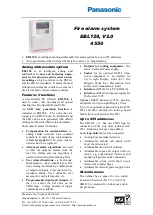
S
Y
S
T
E
M
S
E
N
S
O
R
13
Smoke detectors are designed
to be as maintenance free as
possible. However, dust, dirt,
and other foreign matter can
accumulate inside a detector’s
sensing elements and change
its sensitivity. They can
become either more sensitive, which may cause unwanted
alarms, or less sensitive, which could reduce the amount of
warning time given in case of a fire. Both are undesirable.
Therefore, detectors should be tested periodically and
maintained at regular intervals. Follow closely the manu-
facturer’s specific recommended practices for maintenance
and testing. Also refer to Appendix B of NFPA 90A and
NFPA 72, Chapter 7.
Typical Inspection, Test and Maintenance
Practices
Detectors should be given a visual inspection at installation
and at least twice a year thereafter. This ensures that each
detector remains in good physical condition and that there
are no changes that would affect detector performance,
such as building modifications, occupancy hazards, and
environmental effects.
Notify the proper authorities that the smoke detector is
undergoing maintenance, and therefore the system will
temporarily be out of service. NOTE: Disable the zone or
system undergoing maintenance to prevent unwanted
alarms and possible dispatch of the fire department.
Use a high power vacuum cleaner and remove dust from
the detector by placing the nozzle as close as possible to
the openings in the outside housing. A nozzle with a brush
attachment will assist in dust removal. Some detector’s
sensing chambers can be removed for more thorough
cleaning; refer to the manufacturer’s recommended proce-
dure for details.
Test each detector’s sensitivity per the manufacturer’s rec-
ommended procedure within one year after installation
and every alternate year thereafter.
Test each detector functionally in place annually, as
detailed in NFPA 72 1999 (Chapter 7).
If a detector’s sensitivity is within specifications, nothing
further needs to be done to the detector. If the detector’s
sensitivity is outside specifications, clean the detector and
retest. If that does not place the sensitivity within the unit
specified range then follow the manufacturer’s recom-
mended procedure.
Restore zone or system at the completion of testing.
Notify the proper authorities that testing has been com-
pleted and the system is again operational.
Refer to paragraph 7-4.1 of NFPA 72 for additional infor-
mation.
To assure that each smoke detector is within its listed and
marked sensitivity range it should be tested using either:
• A calibrated test method, or
• The manufacturer’s calibrated sensitivity test instru-
ment, or
• Listed control equipment arranged for the purpose, or
• Other calibrated sensitivity test method acceptable to
the authority having jurisdiction.
Detectors found to have a sensitivity of 0.25 percent/ft.
obscuration or more outside the listed and marked sensi-
tivity range should be cleaned and recalibrated or replaced.
Exception: Detectors listed as field adjustable may be
either adjusted within the listed and marked sensitivity
range, cleaned and recalibrated, or replaced.
Restore the zone or system at the completion of testing.
Notify all the persons contacted at the beginning of the test
that testing has been completed and the system is again
operational.
Some individuals rely on an aerosol chemical spray to test
the sensitivity of a detector. This can give unsatisfactory
results since an aerosol chemical spray does not accurate-
ly test detector sensitivity. NFPA 72-1999, Chapter 7,
Section 7-3.2.1 notes that, “The detector sensitivity shall
not be tested or measured using any device that adminis-
ters an unmeasured concentration of smoke or other
aerosol into the detector.” The duration of spray, distance
between the detector and the aerosol container, angle of
discharge, and different environmental conditions can pro-
duce random results. In addition, many aerosols leave an
oily residue. Over a period of time, this oily residue can
attract dust or dirt, which can make a detector more sensi-
tive and result in nuisance alarms.
Be sure to follow the manufacturer’s recommendation on
test gas, aerosol or smoke.
Section 5
Testing,
Maintenance
and Service of
Detectors
Caution
Smoke detectors are sophisticated electronic devices that
need periodic testing and maintenance. To maintain the
integrity of any fire alarm system, it is important to have a
qualified person periodically test the system.







































